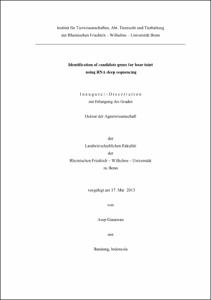Gunawan, Asep: Identification of candidate genes for boar taint using RNA deep sequencing. - Bonn, 2013. - Dissertation, Rheinische Friedrich-Wilhelms-Universität Bonn.
Online-Ausgabe in bonndoc: https://nbn-resolving.org/urn:nbn:de:hbz:5n-32883
Online-Ausgabe in bonndoc: https://nbn-resolving.org/urn:nbn:de:hbz:5n-32883
@phdthesis{handle:20.500.11811/5551,
urn: https://nbn-resolving.org/urn:nbn:de:hbz:5n-32883,
author = {{Asep Gunawan}},
title = {Identification of candidate genes for boar taint using RNA deep sequencing},
school = {Rheinische Friedrich-Wilhelms-Universität Bonn},
year = 2013,
month = jul,
note = {The aim of the present study was to identify candidate genes for boar taint using RNA deep sequencing. For this purpose, two experiments were performed. In the first experiment, transcriptome profiling was analyzed in the testis and liver tissues between boars with high and low androstenone levels in their backfat and polymorphisms that appeared on the differentially expressed genes. In the second experiment, differential gene expression analysis was performed in the liver tissues of boars with high skatole and low skatole in their backfat, differential exon expression and association analysis of gene variants that appeared on the selected differentially expressed genes. In the first experiment, the total number of reads produced for each testis and liver sample ranged from 13.2 to 33.2 million and 12.7 to 46.0, respectively. In testis samples, 46 genes were differentially regulated, whereas 25 genes showed differential expression in the liver. Differentially regulated genes in high androstenone testis and liver samples were enriched in metabolic processes such as lipid metabolism, small molecule biochemistry and molecular transport. Moreover, polymorphism and association analysis revealed mutations in IRG6, MX1, IFIT2, CYP7A1, FMO5 and KRT18 genes that could be potential candidate markers for androstenone levels in boars. In the second experiment, the total number of reads produced for each liver sample ranged from 11.8 to 39.0 million with a median of 22.8 million. Approximately 448 genes were differentially regulated at a strict false discovery rate (FDR) <0.05. Among them, 383 genes were significantly up-regulated in higher skatole group and 65 were significantly downregulated (p<0.01, FC > 1.5). Differentially regulated genes in high skatole liver samples were enriched in metabolic processes such as small molecule biochemistry, protein synthesis, carbohydrate metabolism, energy production, lipid metabolism and amino acid metabolism. Gene expression analysis identified candidate genes in ATP binding, cytochrome P450, keratin, phosphoglucomutase, isocitrate dehydrogenase and solute carier family. Additionally, association analysis suggested that gene variants in ATP5B, KRT8, PGM1 and SLC22A7 might be potential candidate markers for skatole levels in boars. Furthermore, differential exon usages analysis of three genes (ATP5B, KRT8 and PGM1) revealed significant differential exons expression of these genes between the high and low skatole group. The results of these two experiments postulated several metabolic pathways, genes and their polymorphisms, and differential exon expressions that might be involved in the controlling of boar taint compounds levels with an aim to indetify potential candidate genes for boar taint related traits. However, further validation is required to confirm the effect of these genetic markers in other animal populations.},
url = {https://hdl.handle.net/20.500.11811/5551}
}
urn: https://nbn-resolving.org/urn:nbn:de:hbz:5n-32883,
author = {{Asep Gunawan}},
title = {Identification of candidate genes for boar taint using RNA deep sequencing},
school = {Rheinische Friedrich-Wilhelms-Universität Bonn},
year = 2013,
month = jul,
note = {The aim of the present study was to identify candidate genes for boar taint using RNA deep sequencing. For this purpose, two experiments were performed. In the first experiment, transcriptome profiling was analyzed in the testis and liver tissues between boars with high and low androstenone levels in their backfat and polymorphisms that appeared on the differentially expressed genes. In the second experiment, differential gene expression analysis was performed in the liver tissues of boars with high skatole and low skatole in their backfat, differential exon expression and association analysis of gene variants that appeared on the selected differentially expressed genes. In the first experiment, the total number of reads produced for each testis and liver sample ranged from 13.2 to 33.2 million and 12.7 to 46.0, respectively. In testis samples, 46 genes were differentially regulated, whereas 25 genes showed differential expression in the liver. Differentially regulated genes in high androstenone testis and liver samples were enriched in metabolic processes such as lipid metabolism, small molecule biochemistry and molecular transport. Moreover, polymorphism and association analysis revealed mutations in IRG6, MX1, IFIT2, CYP7A1, FMO5 and KRT18 genes that could be potential candidate markers for androstenone levels in boars. In the second experiment, the total number of reads produced for each liver sample ranged from 11.8 to 39.0 million with a median of 22.8 million. Approximately 448 genes were differentially regulated at a strict false discovery rate (FDR) <0.05. Among them, 383 genes were significantly up-regulated in higher skatole group and 65 were significantly downregulated (p<0.01, FC > 1.5). Differentially regulated genes in high skatole liver samples were enriched in metabolic processes such as small molecule biochemistry, protein synthesis, carbohydrate metabolism, energy production, lipid metabolism and amino acid metabolism. Gene expression analysis identified candidate genes in ATP binding, cytochrome P450, keratin, phosphoglucomutase, isocitrate dehydrogenase and solute carier family. Additionally, association analysis suggested that gene variants in ATP5B, KRT8, PGM1 and SLC22A7 might be potential candidate markers for skatole levels in boars. Furthermore, differential exon usages analysis of three genes (ATP5B, KRT8 and PGM1) revealed significant differential exons expression of these genes between the high and low skatole group. The results of these two experiments postulated several metabolic pathways, genes and their polymorphisms, and differential exon expressions that might be involved in the controlling of boar taint compounds levels with an aim to indetify potential candidate genes for boar taint related traits. However, further validation is required to confirm the effect of these genetic markers in other animal populations.},
url = {https://hdl.handle.net/20.500.11811/5551}
}






